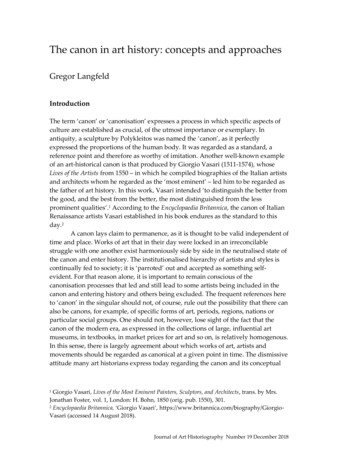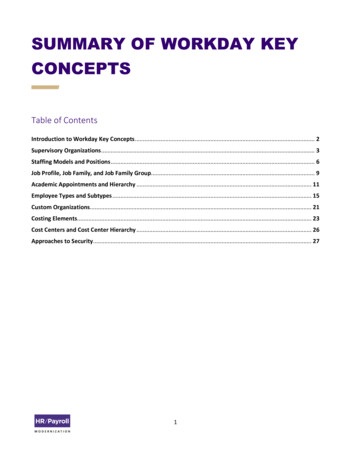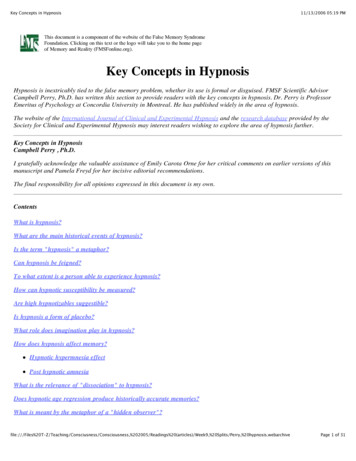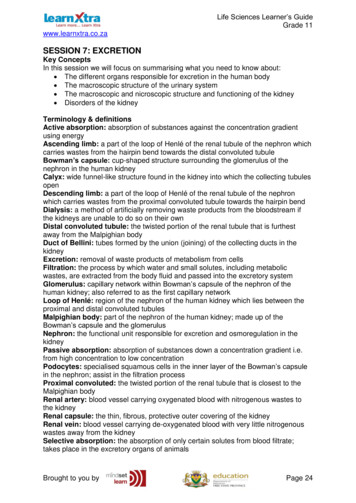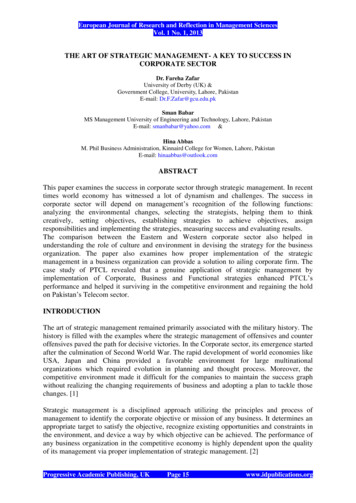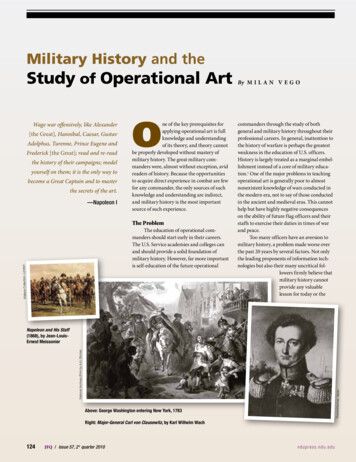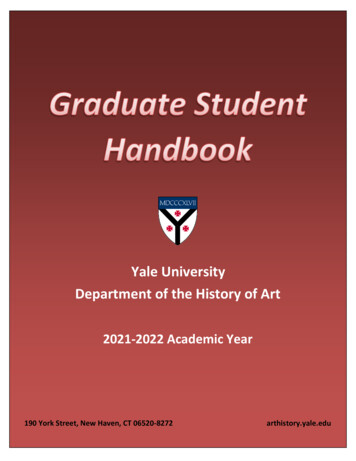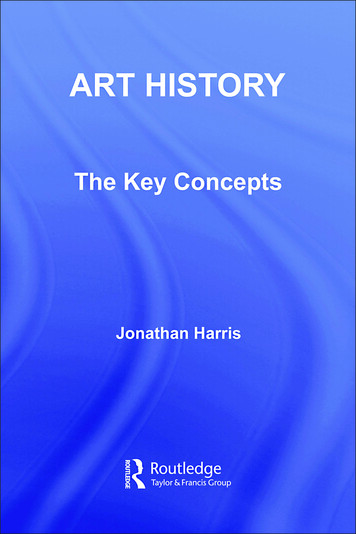
Transcription
A RT HI S TO RY:THE KEY CONCEPTSArt History: The Key Concepts offers a systematic, reliable, accessible,and challenging reference guide to the disciplines of art history andvisual culture. Containing entries on over 200 terms integral to thehistorical and theoretical study of art, design, and culture in general,Art History: The Key Concepts is an indispensable source of knowledgefor all students, scholars, and teachers. Each entry contains a succinctdefinition, an exploration of its history, use, and significance, andsuggestions for further reading. Entries include: Abstract gh extended cross referencing, Art History: The Key Conceptsbuilds a radical intellectual synthesis for understanding and teachingart, art history, and visual culture.Jonathan Harris is Professor of Art History at the University ofLiverpool. He is the author of Writing Back to Modern Art: AfterGreenberg, Fried, and Clark (Routledge, 2005) and The New Art History: A Critical Introduction (Routledge, 2001). Jonathan Harris alsowrote introductions to the four volumes of Arnold Hauser’s 1951classic The Social History of Art, republished by Routledge in 1999.
ALSO AVAILABLE FROMRO UTLEDGEKey Writers on Art: From Antiquity to the Nineteenth CenturyEdited by Chris Murray0–415–24302–5Key Writers on Art: The Twentieth CenturyEdited by Chris Murray0–415–22202–8Cultural Theory: The Key ConceptsEdited by Andrew Edgar and Peter Sedgwick0–415–28426–0Theory for Art HistoryJae Emerling0–415–97364–0
A RT HI S TO RYThe Key ConceptsJonathan Harris
First published 2006by Routledge2 Park Square, Milton Park, Abingdon, Oxon OX14 4RNSimultaneously published in the USA and Canadaby Routledge270 Madison Ave, New York, NY 10016This edition published in the Taylor & Francis e-Library, 2006.“To purchase your own copy of this or any of Taylor & Francis or Routledge’scollection of thousands of eBooks please go to www.eBookstore.tandf.co.uk.”Routledge is an imprint of the Taylor & Francis Group, an informa business# 2006 Jonathan HarrisAll rights reserved. No part of this book may be reprinted or reproduced or utilised in anym or by any electronic, mechanical, or other means, now known or hereafter invented,forincluding photocopying and recording, or in any information storage or retrieval system,without permission in writing from the publishers.British Library Cataloguing in Publication DataA catalogue record for this book is available from the British LibraryLibrary of Congress Cataloging in Publication DataA catalog record for this book has been requestedISBN10: 0 415 31976 5 (hbk)ISBN10: 0 415 31977 3 (pbk)ISBN10: 0 203 62719 9 (ebk)ISBN13: 978 0 415 31976 8 (hbk)ISBN13: 978 0 415 31977 5 (pbk)ISBN13: 978 0 203 62719 8 (ebk)
As ever: for Jules and Jim, my extraordinary sons
CONTENTSList of Key ConceptsAcknowledgementsIntroductionviiixixiiKEY CONCEPTS1Name Index340vii
LIST OF KEY CONCEPTSabstract hitecture/architectartart for art’s sakeart historyart nt ptconceptual nventioncraftcreativity/creatorcriticcritical theorycriticismcubismcultural imperialismcultural policycultural studiesculturecurationdadadeconstructiondesign
desiredevelopmentdiscoursedominanteffects chegemonyhermeneuticshigh arthistoryhistory eimpressionisminfluenceinstallation/installation annerismmarxismmass culture/massmasterpiece/old mastermaterials/mattermeaningmeans of productionmediamediationmedieval art/medieval/middle mural sicismnew art historynew medianudeoppositionalorganisation
tronperformance/performance artperiodperspectivephotographypicturepop/pop art/popularpopular cultureportraiturepostcolonialpostcolonial psychoanalysis/psychologypublic sign/significance/significant/signifying systemsocial/society/sociology/sociosocial history of artsocial ordersocial realism/socialist realismsocial relations of production andconsumptionspecialistsponsorshipstatestill lifestructuralism/structurestylesubculturesubject isual/visible/visionvisual culturevisual pleasurewesternzeitgeist
AC K N OW L E D G E M E N T SWriting this book has involved much reflection on the last 25 yearsof my academic and personal life. My debts are many and deep. I amglad to say that my friendships and intellectual relations have mergedin nearly all significant cases. Raymond Williams remains my mentor,example, and was the inspiration for this project, yet he died not longafter I had finished my PhD in 1986. I am very glad to say that TimClark – worthy supportive adversary of Williams! – has been a personal and intellectual beacon of light for me from our first meeting atHarvard the following year. Fred Orton, Alan Wallach, Colin Trodd,Marcia Pointon, Al Boime, David Craven, Eric Fernie, and AnneMacPhee have been very valuable friends, defenders, and criticalinterlocutors for many years on both sides of the Atlantic. I shouldlike particularly to thank two professors of science (the dark arts, asfar as I’m concerned) in the School of Architecture at the Universityof Liverpool – David Oldham and Barry Gibbs – whose amiabilityand good humour have been a valuable support to me over the lastseven years. My ‘extended’ family – Lucy, Tom, Kate, Pie, Tim, Philand their families – have been crucial to my stability and happinessfor many years now. I must thank Tom Hills in particular for hiscareful reading and assiduous commentary on my book in an earlierform. Jane Linden has stuck to me through thick and thin times,tenaciously caring and interested in me and my obsessions. Oh that Icould repay you! Thank you. And to my beloved sons, Jim and Jules:I hope you might open this book if you ever become interested in arthistory. You’ll glimpse me here and there amongst the pages.xi
INTRODUCTIONThis book is designed specifically for use by students and scholars ofart history and visual culture. It is intended as a reference source forthose involved in teaching and learning (on either side of the fence,as teacher or pupil) and as an aid for those carrying out researchactivities. These two areas overlap considerably: ‘research’ isn’t justthe province of PhD students or professional academics or museumcurators. Any student – of any age – trying to answer an essay question, or preparing a presentation for a seminar, or following up notesmade after attending a lecture or reading a book, is engaged in aresearch task too. Art History: The Key Concepts, if it is to succeed as Iintend and hope, will help people in all of these situations. Eachentry provides: (1) the basic definition of a term; (2) an exploration ofsome of the complexities of its development, function, and significance; (3) some illustrative historical or contemporary examples ofartworks or items of visual culture related to this concept; and (4)some bibliographic references that will enable the reader to follow upthe term and the ways in which it has been used in actual researchand scholarship. After consulting an entry the reader should feel confident that they could use the term appropriately themselves and havesome insight into its range of meanings and contexts of application.Each entry begins with the term (and occasionally a related termor terms) identified in bold, followed by other important forms ofthe word identified in italics. For example:explanation explain, explanatoryAs the example indicates, this reference book is not limited towords thought of as specifically, or uniquely, ‘art historical’. I haveincluded many terms here which inevitably and necessarily form partof any serious pedagogic or research task. I indicate both their generaland specific art historical significance. In addition, I have tried toshow that art history is a changing and contested discipline, subject toxii
INTRODUCTIONlong standing debates over arguments and methods, values and basicprinciples for many decades now.1 These debates inform all of thecomponents of the contemporary language of art history. Beyond thatsituation internal to the discipline, however, a new, related field ofinquiry – visual culture – has developed over the past decade or two.Though certainly still reliant on art history for much of its terminology, visual culture also takes its leave of it in many ways: forinstance, by fashioning its ‘own’ concepts. So, in a way, this bookthrough its range of entries charts the intersection or convergence ofone traditional disciplinary inquiry (art history) with another emergentone (visual culture). In the text for the entries you will see somewords identified in bold – sometimes several consecutively. Thismeans that the word, or term involving more than one word, in bold(e.g. cultural imperialism) has its own entry. Occasionally the sign accompanies a word in bold which is followed by another in bold(e.g. critical analysis): this tells you that there are separate entriesfor both words, though sometimes there is also an entry for the termformed by the words in combination (e.g. art history – entries areprovided for art, history, and art history).Use of the term ‘language’, however, can be confusing and misleading. People do not speak ‘art history’ or ‘visual culture’ the waythey speak English or French: you cannot make sense of the world(either in giving lectures or presentations or writing books or essays)simply through the use of what are regarded as disciplinary terms.Much intellectual work and its communication lies in theprocedures – and the words we have for them – that appear to benon disciplinary specific and even non conceptual. These proceduresand terms are indispensable to the general activity of students andscholars of art history and visual culture: the attempt to explain,involving processes of analysis and interpretation (all key terms includedhere). At some level, then, all of us involved in art history and visualculture have to grapple with the most basic of things – questions, forinstance, to do with meaning and conceptual thinking (both termsincluded here). Scholarship and research is actually built up fromthese core assumptions and the forms of thinking and acting theygenerate. I try to relate many of these ‘building block’ terms andvalues to the orthodox concepts constituting art history as a disciplinary (yet plural, disputed) field, while at the same time indicating1 For an account of this, see my The New Art History: A Critical Introduction(Routledge: London and New York, 2001).xiii
INTRODUCTIONthat visual culture – not yet a fixed discipline – offers some new andvaluable insights.Given this range of terms included and an inevitable limit on theword length for the book, it is no surprise that not every term Iwould have liked to include is actually here. More will be included, I hope, in a subsequent edition – including many suggestionssupplied by my four anonymous readers who made extremely helpfulcomments on the manuscript at an early stage in its development. Mycriteria for inclusion of terms have been partly intellectual and partlypragmatic: I wanted to get a reasonable mixture – given its primaryintended use – of orthodox art historical, new visual cultural, and whatI’ve called building block terms. As a reference source aiming at reasonable comprehensiveness, yet exploring the concerns and limits ofart history thinking, it bears most useful comparison in method andambition with the book that influenced me greatly as a student,Raymond Williams’s Keywords: A Vocabulary of Culture and Society.2That is to say, my book is both a reference source and an extendedargument. I have tried to assemble a coherent, accessible, andsophisticated conceptual system for the analysis of visual arts andvisual cultural materials, while at the same time not minimising theintellectual tensions both inside art history and between art historyand the nascent subject of visual culture. I would like to hear fromany readers who think that I have missed anything vital to the terms Ihave included here, and welcome arguments and suggestions for further terms to be included in the future. Languages and disciplines arealways spoken collectively, not by individuals – my hope is that thisbook will enable younger people to begin to speak and help thosewho have already mastered the basics (and far beyond, of course) tothink through change and find the means to generate positivemeanings for the future.Jonathan HarrisCongleton, Cheshire, March 20062 Published originally by Fontana Press, 1976; revised and expanded by Flamingo, 1983.xiv
A RT HI S TO RYThe Key Concepts
ABSTRACT EXPRESSIONISMABSTRACT EXPRESSIONISM ABSTRACTEXPRESSION, AMERICAN ABSTRACTEXPRESSIONISTThis composite term was one of several coined to identify the workof a number of fairly loosely associated artists based in the US andactive from the late 1940s. It is important to note, however, that this,the most successful – that is, used – name (coined by the critic RobertCoates in 1946) was not the invention of any of the artists themselves,nor did they endorse it as an accurate description of their activitiesand interests. Five of the key artists identified as American abstract expressionists – Jackson Pollock, Mark Rothko, Barnett Newman,Robert Motherwell, and Willem de Kooning – were resident in NewYork, a metropolitan centre that had become home to many European modernist artists in the 1930s who had gone there to escapethe nazis and coming war in Europe. Surrealist artists in particular,such as Joan Miró and André Masson, are credited with influencingin a number of important ways the chief ideas, technical procedures,and stylistic concerns of some of the abstract expressionists, though avery much wider range of artistic and socio -cultural sources maybe detected in the development of these artists’ work, includingpsychoanalytic theories, Greek and Roman myths, Jewish theology, anthropological discourse, Native American totemic sculptureand religion, as well as art by ‘the European Greats’ of the inter warperiod – particularly Henri Matisse, Pablo Picasso, and the aforementioned abstract (that is, non figurative) surrealist painters.Most artists identified as abstract expressionists after 1945 had beencommitted to forms of social realism or socialist realism in the1930s during the Depression and New Deal period in the US,having then embraced liberal left or communist political beliefs associated with varying degrees of support for the USSR. With therevelations of Joseph Stalin’s purges of his opposition there in the later1930s, the rise of anti communism in the US, and the ending of theNew Deal’s radical economic and social reform programme in theearly 1940s, artists generally became disillusioned and individualistic,seeking to find modes of expression that they thought could transcend the horrors of world war, the failure of radical political beliefs,and the growing alienation they felt in 1950s American consumer capitalist society. As the two elements of the term suggest, paintingsby these artists brought together abstract (and non narrative) pictorial conventions with expressive, non illusionistic devices forconveying feeling, though there was a wide variety of both, and the3
ABSTRACTIONextent of contrast can be seen by comparing, for instance, a Pollock‘drip painting’, such as Number One 1948 (1948), with the ‘colourfield’ effect of Rothko’s Light Red over Black (1957). Works by otherabstract expressionists, such as Adolph Gottlieb and Clyfford Stillclearly fall between the ‘drip’ and the ‘field’ categories, combiningelements of both in various ways.Since the 1970s art critics and historians have reappraised themovement in a number of ways: for instance, looking at themanipulation of abstract expressionism ‘as a weapon of the cold war’during the 1950s and 1960s – the main interest of social historiansof art. In a different direction, more recent scholarship has examinedhow the ‘Americanness’ of this art actually concerned much morethan simply the US government’s post 1945 cold war political ideological agenda. Questions of gender, feminism, and the relationshipbetween expressiveness, action, aesthetics, and sexuality have beenraised, though the phase ‘women abstract expressionist’ still seems anunlikely combination (like ‘women surrealist’), despite the fact that,for instance, Grace Hartigan, Lee Krasner, and Helen Frankenthalerhave long been identified as – marginal – members of the overallgrouping. Recent research has stressed the importance of AfricanAmerican abstract expressionists, such as Norman Lewis, and investigated the reasons why, despite accusations of its Cold War imperialist character, some Latin American critics and artists positivelyembraced abstract expressionism as a model of artistic freedom.Further ReadingCraven, David Abstract Expressionism as Cultural Critique: Dissent during theMcCarthy Period (Cambridge University Press: 1999).Frascina, Francis (ed.) Pollock and After: The Critical Debate (Routledge: 2000).Guilbaut, Serge How New York Stole the Idea of Modern Art: Abstract Expressionism, Freedom, and the Cold War (University of Chicago Press: 1983).Leja, Michael Reframing Abstract Expressionism: Subjectivity and Painting in the1940s (Yale University Press: 1993).ABSTRACTION ABSTRACT, ABSTRACTED,ABSTRACTING, ABSTRACTIONISTIn perhaps its two most familiar uses – that is, as a noun (abstraction)and an adjective (abstract) – this term denotes artworks that appearnot to depict or include reference to objects (and figures) or eventsin the real world. Recognising this definition as negative is important4
ABSTRACTIONbecause it indicates how theories and histories of abstraction inmodern art developed in the early twentieth century partly ascritiques of traditional naturalistic or realist representational pictorial conventions. Wassily Kandinsky is often credited withthe title of being the first abstract painter, with works such as Withthe Black Arch (1913). However, in western art history concernedwith pre modern painting and sculpture (in this epochal sensemodern is opposed to the general category of ancient art, that is,works produced before the birth of Christ), abstraction and naturalism are concepts used to identify a range of stylistic characteristics seen as at either ends of a continuum of representationalforms, with the more abstract examples considered to be highly stylised. Such works include, for example, the marble Kouros, a sculptureof a man, dedicated to Poseidon at Sunium (about 590 BCE).In relation to twentieth century art, architecture, and design,however, theories and practices of abstraction are modernist inorigin, and relate to the development of avant-garde painting andsculpture in particular. In whatever context of usage, though, theterm abstraction has important art historical and philosophical dimensions, the latter particularly connected to accounts of the kind ofknowledge or insights that art has been claimed to produce. Inone of its simplest art historical uses the term functions descriptively:for example, ‘Morris Louis was an abstract painter’. That is, Louis’spainting, such as Blue Veil (1958–59), expresses – that is, communicates ideas and feelings – through the use of colour, pattern, andfacture (the character of the painted surface) alone. Louis’s paintingshave been closely related to the work of earlier, abstract expressionist, artists. On the other hand, Piet Mondrian’s paintings, suchas Composition with Red, Yellow, and Blue (1921), have sometimes beendescribed as examples of geometric, or ‘cool’ (suggesting highlycontrolled), abstraction. Many other twentieth century modernistmovements have been associated with abstraction, or the ‘abstracting of content’, including futurism, cubism, and some aspects ofsurrealism. In architecture, Le Corbusier, and in design those associated with De Stijl and the Bauhaus have also been seen as particularly interested in abstraction and its use in the creation of objectsfor practical rather than for aesthetic contemplation.These factual examples, however, entail a wide range of theoreticalcomplexities and problems that attend on the notion of abstraction.While a contrast with naturalistic conventions in nineteenth centuryacademic painting (e.g.: William Frith’s Derby Day (1858)) emphasisesthat abstraction in modernist art avoids depicting the literal appearance5
ACADEMYof the world, all so called abstract paintings and sculptures necessarilycommunicate meanings through some kind of formal compositionalmeans and in that process create symbols referring to the world(including the ‘world’ of subjective feelings and experiences).Further ReadingArt & Language ‘Abstract Expression‘ (1982), in Charles Harrison and FredOrton (eds.) Modernism, Criticism, Realism: Alternative Contexts for Art(Harper and Row: 1994).Cheetham, Mark A. The Rhetoric of Purity: Essentialist Theory and the Advent ofAbstract Painting (Cambridge University Press: 1991).Greenberg, Clement ‘Abstract, Representational, and So Forth’ (1974), inRobert C. Morgan (ed.) Clement Greenberg: Late Writings (University ofMinnesota Press: 2003).Osborne, Harold Abstraction and Artifice in Twentieth Century Art (OxfordUniversity Press: 1979).ACADEMY ACADEMIC, ACADEMICISEThe inauguration of artistic education within officially recognisedacademies was one of the most significant institutional developmentsin the social history of renaissance art. Academic qualificationand subsequent life membership – for instance, being able to use theinitials R.A. (Royal Academician) after one’s name – led to the professionalisation of artists and the elevation of their status to a categoryfar beyond that of contemporary artisans and craft-workers.Though western artists had been trained and accredited with technical and social standing in some earlier kinds of organisation, suchas monasteries, workshops, and guilds, the opening of the first academies, or art schools, for painters and sculptors in the city statesof southern Europe (Vatican, 1531; Florence, 1563; Rome 1593;Bologna, 1598), and in France (1648), and England (1768), generateda wholly new understanding of the meaning and value of art andthe role of artists in those societies. The academies also importantlycontributed to, and were themselves part product of, a newly forgedsocial order in western and southern Europe based on mercantilecapitalism and the rise to power of a wealthy new middle class. Inaddition, however, these first academies were usually also closelyrelated to, and in some cases dependent upon, the support ofmonarchies – particularly in France and Britain – and to that extentthey were the institutional creatures of emerging nation -states,6
ACADEMYreflecting in their organisation and activities the complex politicalforces attempting to lead these rapidly transforming societies.Academies sought to select, train, educate, commission, andaccredit artists and in doing so produced an elite group of workerswhose skills and intellectual abilities were put to work makingpaintings and sculptures to adorn and embellish public buildings ofmany kinds, including palaces, parliaments, churches, and the newlycreated state art museums, such as the Louvre in Paris whichbecame an art gallery after the French Revolution of 1789. Accredited artists (known as ‘Royal Academicians’ in England) also workedfor private patrons in many countries throughout the world by thenineteenth century. Contemporary art schools, colleges, and departments of art in universities in Europe and North America owe theirexistence, via a complicated history, to the founding of academies inthe renaissance and enlightenment epochs (c. 1500–1800) and theprocesses of qualification and professional accreditation have theirroots in the social division of labour developing in the societies thatinaugurated the first academies.By the mid to late nineteenth century in Europe many societieswith official academies of art had entered a period of sustainedeconomic, social and political crisis – the latter related to the growthin popular movements for democratic and then socialist revolution. Under these conditions the terms academy and academic began togenerate negative connotations, as these institutions were increasinglyidentified as part of a conservative state attempting to preventchange in the nation’s cultural, as well as social, order. Nationalacademies of art lost power, status, and influence as modern or,more strongly, avant-garde artists (e.g.: the impressionists), by the1860s, 1870s, and 1880s, particularly in France, began to produceworks appealing to a new middle class itself critical of, or at leastincreasingly indifferent to, established taste and artistic tradition symbolised by an old fashioned academic – academicising – focuson life drawing, and the rote production of preparatory sketchesand models for history paintings and large scale monumentalsculptures.Further ReadingBoime, Albert The Academy and French Painting in the Nineteenth Century(Phaidon: 1971).Hoock, Holger The King’s Artists: The Royal Academy of Arts and the Politics ofBritish Culture: 1760–1840 (Clarendon Press: 2003).7
ADVERTISINGPointon, Marcia (ed.) Art Apart: Artifacts, Institutions, and Ideology in Englandand North America from 1800 to the Present (Manchester University Press:1994).Singerman, Howard Art Subjects: Making Artists in the American University(University of California Press: 1999).ADVERTISING AD, ADVERTISEMENTGraphic representations combining the use of visual and textual(sometimes, in addition, recorded spoken) materials in the effort tosell products, services, images of life styles, and brand identitiesin, for example, newspapers, magazines, and on billboards, television, and the internet. The origins of advertising lie in eighteenthcentury print media – principally the then newly developingnewspaper or ‘broadsheet’ and journal forms – and consisted in‘classified notices’ (that is, classed or boxed according to variouscategories) informing readers that certain goods or services wereavailable for their purchase. These referred to, for instance, accommodation, food and dining, transport, and legal advice. In this earlyand comparatively straightforward example ‘information’ is perhaps amore accurate term than ‘advertisement’ for a simple and obviouslyuseful kind of notification. However, these origins led to a profound,even transforming, cultural development in modern societiesthat now includes the complex and expensive forms of the television ad, large scale billboard images (sometimes the size of the sidesof entire buildings), film (movie) ‘trailers’, and the use of rapidlyinnovating internet computer formats. Advertising in these contemporary examples refers to a sophisticated, continual, and systematiceffort to convince viewers or readers – now abstractly referred toby advertising executives as consumers – that they would be muchbetter off if they wore Levi’s jeans, or ate Domino pizzas, or droveFord cars.The combination of visual and textual/spoken elements withinmagazine or television advertising constitutes an effective system ofrhetorical selling devices designed to persuade. For instance, advertstypically draw attention to, play on, and even attempt to manufacture,the psychological weaknesses of their ‘target audience’ (for example,the dire threats of baldness or ageing skin quality), habitually use bothexplicit and subtle forms of sexual imagery (linking products tosexual success), engage the ‘identificatory processes’ of viewerrecognition (by paying celebrities or trusted public figures hugesums to endorse products and services), and insist that their products8
AESTHETICcan bestow clear advantage on those who purchase and continue touse them.By the 1970s it had become clear that a considerable part of whatone critic (Peter Fuller) called ‘the mega visual’ tradition – largescale graphic art, in the nineteenth century exemplified by historypaintings – was now devoted to advertising and that the publicculture of western societies as a whole was being transformed byinnovations in advertising and the consumer capitalist system driving its development. Numerous critiques of this ‘advertising culture’,founded on the priority accorded to selling and persuasion techniques, claimed that a wholesale corruption of the social order ofwestern democratic societies was taking place: that national politicallife in particular, through the use of ‘sound bites’ and ‘spin’, hadbecome simply another form of clever advertising equated with adeceitful manipulation and misleading of the public. Political advertising techniques using sophisticated narrative and dramatic devicesdeveloped in television and film drama contributed to the developm
May 24, 1974 · Art History: The Key Concepts offers a systematic, reliable, accessible, and challenging reference guide to the disciplines of art history and visual culture. Containing entries on over 200 terms integral to the historical and theoretical study of art, design, and culture in general, Art History
